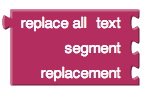- string
- join
- length
- is empty
- compare texts
- trim
- upcase
- downcase
- starts at
- contains
- contains any
- contains all
- split at first
- split at first of any
- split
- split at any
- split at spaces
- segment
- replace all
- obfuscated text
- is a string?
- reverse
- replace all mappings
” “ (string block)

Contains a text string.
This string can contain any characters (letters, numbers, or other special characters). On App Inventor it will be considered a Text object.
join

Appends all of the inputs to make a single string. If no inputs, returns an empty string.
length

Returns the number of characters including spaces in the string. This is the length of the given text string.
is empty

Returns whether or not the string contains any characters (including spaces). When the string length is 0, returns true otherwise it returns false.
compare texts < > = ≠

Returns whether or not the first string is lexicographically <, >, =, or ≠ the second string depending on which dropdown is selected.
A string a considered lexicographically greater than another if it is alphabetically greater than the other string. Essentially, it would come after it in the dictionary. All uppercase letters are considered smaller or to occur before lowercase letters. cat would be > Cat.
trim

Removes any spaces leading or trailing the input string and returns the result.
upcase

Returns a copy of its text string argument converted to all upper case.
downcase

Returns a copy of its text string argument converted to all lower case.
starts at

Returns the character position where the first character of piece first appears in text, or 0 if not present. For example, the location of ana in havana banana is 4.
contains

Returns true if piece appears in text; otherwise, returns false.
contains any

Returns true if any of the pieces in the piece list appear in text; otherwise, returns false.
This block can be obtained by changing the dropdown on the contains block.
contains all

Returns true if all of the pieces in the piece list appear in text; otherwise, returns false.
This block can be obtained by changing the dropdown on the contains block.
split at first

Divides the given text into two pieces using the location of the first occurrence of at as the dividing point, and returns a two-item list consisting of the piece before the dividing point and the piece after the dividing point. Splitting apple,banana,cherry,dogfood with a comma as the splitting point returns a list of two items: the first is the text apple and the second is the text banana,cherry,dogfood. Notice that the comma after apple doesn’t appear in the result, because that is the dividing point.
split at first of any

Divides the given text into a two-item list, using the first location of any item in the list at as the dividing point.
Splitting i love apples bananas apples grapes by the list [ba,ap] would result in a list of two items the first being i love and the second ples bananas apples grapes.
split

Divides text into pieces using at as the dividing points and produces a list of the results. Splitting one,two,three,four at , (comma) returns the list (one two three four). Splitting one-potato,two-potato,three-potato,four at -potato, returns the list (one two three four).
split at any

Divides the given text into a list, using any of the items in at as the dividing point, and returns a list of the results.
Splitting appleberry,banana,cherry,dogfood with at as the two-element list whose first item is a comma and whose second item is rry returns a list of four items: (applebe banana che dogfood).
split at spaces

Divides the given text at any occurrence of a space, producing a list of the pieces.
segment

Extracts part of the text starting at start position and continuing for length characters.
replace all

Returns a new text string obtained by replacing all occurrences of the substring with the replacement.
Replace all with She loves eating. She loves writing. She loves coding as the text, She as the segment, and Hannah as the replacement would result in Hannah loves eating. Hannah loves writing. Hannah loves coding.
Note: Regular expressions (regex) are patterns used for matching character combinations in strings. When using the “replace all” block, it’s essential to be aware of special characters in regular expressions.Special characters like $, *, ., etc., have special meanings in regular expressions. If you want to use these characters as literal characters in your pattern, you need to escape them with a backslash (\).
Example: replace all with Price: $50.00 as the text, $ as the segment, € as the replacement this would result in Price: €50.00
obfuscated text

Produces text, like a text block. The difference is that th etext is not easily discoverable by examining the app’s contents. Use this when creating apps to distribute that include confidential information, for example, API keys.
Warning: This provides only very low security against expert adversaries.
is a string?

Returns true if thing is a text object, otherwise false.
reverse

Reverse the given text. For example, “reverse” would become “esrever”.
replace all mappings

Given a dictionary of mappings as input, replaces the key entries in the text with the corresponding values in the dictionary. Returns the text with the mappings applied.
dictionary order
If the dictionary order is specified, in the case of one key entry being a substring of another key entry, the first one to be replaced is based on the entry order in the dictionary (the earliest one gets replaced first).
longest string first order
If the longest string order is specified, in the case of one key entry being a substring of another key entry, the first one to be replaced is the one which is longer.